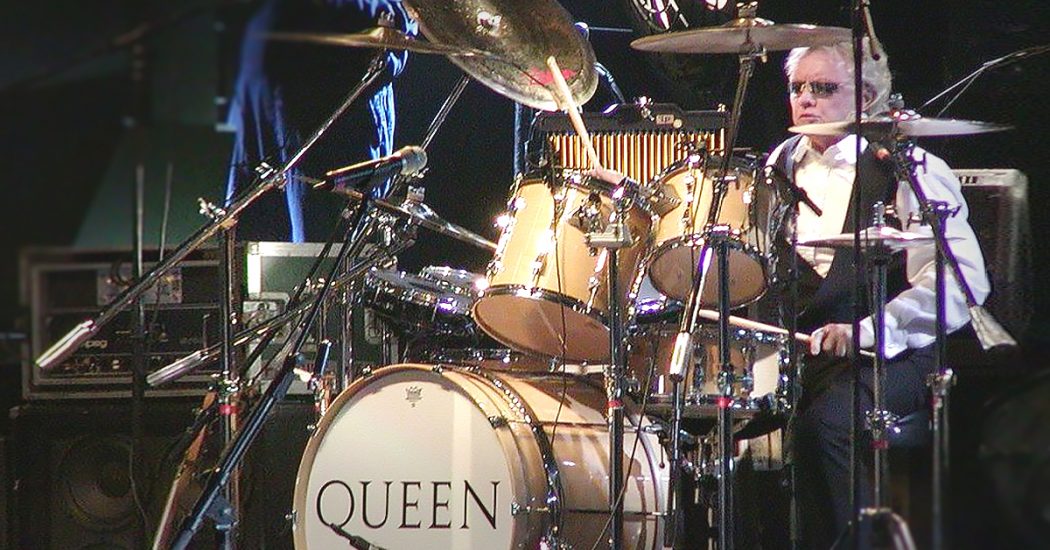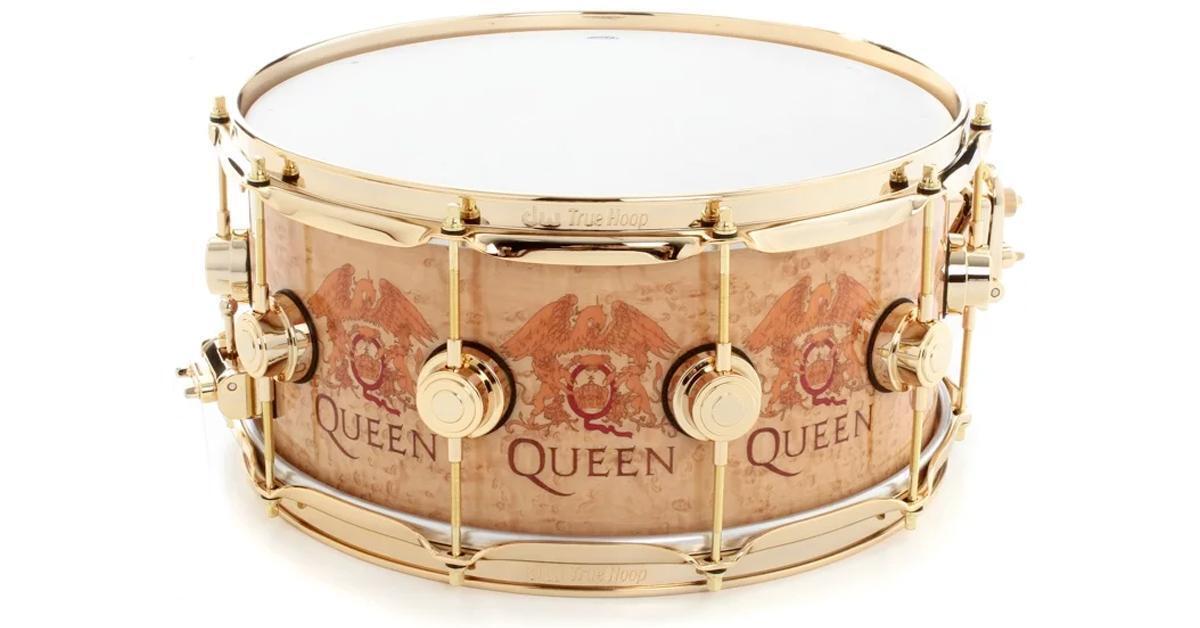
Roger Taylor’s journey to the top of the drumming world began in 1970, in a London supermarket. Roger’s band, Smile, had just broken up, and he was looking for a new gig. He worked next to an aspiring young singer named Farrokh Bulsara. Farrokh convinced Roger to get Smile back together and add a new singer. Shortly after that, Farrokh Bulsara became “Freddie Mercury,” Smile became “Queen,” and rock ‘n’ roll would be changed forever.
Throughout Queen’s reign, Roger’s drumming stood toe-to-toe with Queen’s big sound. “I’ve always liked to use big drums,” Roger explained. “I like big, tuneful drums with a natural room sound, so the whole kit sounds balanced. I wanted it to sound as though it were in a room and you were hearing the reverberation from the walls.” How did he do it? Let’s take a look at Roger’s technique and gear and see if we can figure it out.
The Technique
No one is ever going to accuse Roger Taylor of being a technically superior drummer. Not even Roger. “I just always felt that what came from within was what I ought to play,” he admits. “Every time I see [American drumming great] Carmine Appice he’s going on about all sorts of amazing things. He might as well be talking about cupcakes. No, I’m not really into the technical aspects of drumming at all.”
Roger has even confessed that he has never had a lesson and can only read music slowly. “Obtrusively or unobtrusively, you should play the song, and not think about dots or bars,” he says. “I have a desperate mistrust of dots — you can never put in the dots what is needed. The language simply isn’t good enough.”
Roger’s first tip? Play from the heart. “I think that you should just watch the song and learn the song,” Roger says. “Maybe the beat should be a little bit behind, maybe you should push, whatever. It’s all about feel really.”
So how does Roger generate so much sound? He’ll tell you it’s all in the wrist. “If you’ve got decent wrists, which I think any decent drummer should have, the snap comes from there,” he explains. “That’s what makes it loud. Also, you’ve got to be able to do perfect rimshots. That’s what makes the drums loud, not eight-foot long telegraph poles.”
That’s not to say that Roger didn’t have some tangible tricks up his sleeve. Take his hi-hat work, for instance. Roger would often use the hi-hat to strengthen his backbeats, opening the cymbals in time with the snare to create a bigger sound.
Roger is also a big fan of cymbals, using them to a tasteful excess. “I love cymbals,” claims Roger. “They provide wonderful dynamics. Quite often, I’ll overdub very specific cymbals. Cymbals are very important; you have to know which ones to use in which places.” Here’s how Roger explains his use of the hi-hat and cymbals.
Of course, it never hurts to have a little help from your friends. Roger built a strong rapport with Queen’s drum tech, Chris “Crystal” Taylor. Chris could almost read Roger’s mind and was instantly ready to jump into action when Roger needed him. “During the show we could almost lip read each other, and we had little hand and head signals which meant we could relay messages to each other very easy and quickly,” Chris remembered. “So, for instance, if he wanted Brian’s guitar turned up in his monitors, a couple of quick coded nods and ‘Hey Presto,’ job done and we’re all happy.”
Crystal was even ready to prevent potential disasters. “If the bass drum pedal broke I would grab a new one and dive on to the riser, lying face down between his stool and the floor toms,” he said. “Most of the time he will have moved his foot as much as possible, but if he hadn’t I would tap his ankle so he knew I was there and he would move his foot so the offending pedal could be swapped.”
Play with heart, build up your wrists, reverse the hi-hat, don’t be stingy with the cymbals, treat your tech with respect — sounds like we’re ready to rock like Roger. But what are we hitting? Let’s move on to Roger’s gear.
The Gear
Roger Taylor changes drum kits like he changes shirts. Depending on the size and acoustics of the venue, he has been known to vary his kit to create the perfect sound for that performance. Roger explains it this way: “Live, it all depends on what hall you’re playing,” he says. “Like at the Forum in L.A., it’s easier to get a great drum sound. But on the other hand, it’s hard to get a great drum sound in Madison Square Garden in New York.” Rather than spend the next month showing all of them to you, we are just going to look at a few kits to give you a good idea of the gear he depends on.
According to Larry Pryce’s Queen: An Official Biography, Roger’s drum set in Queen’s early years of success was a heavily customized, matte black Ludwig kit with:
– 26″ bass drum
– 7.5″ x 13″ maple snare drum
– 16″ x 16″ tom
– 20″ x 20″ tom
– Meazzi 13″ x 13″ pedal-tunable tom
– Ludwig and Shaftesbury stands
– Pedals comprised of two Ludwig Speed Kings
– Avedis Zildjian with two 15″ hi-hats
– One 16″, one 20″, and one 22″ Zildjian crash
– One Paiste 15″ crash
– Two matching 602 Paiste crashes
– Three cowbells — one large New Era, one small New Era, and one Ludwig
It would appear that early on Roger was strictly a Ludwig man, but that wasn’t necessarily true. “I have an amazing Gretsch kit in our studio over in Switzerland,” Roger once revealed. “It’s got three toms, a snare and bass drum. It’s a great sounding kit.” His early choice of using Ludwig onstage seems to have been a practical one. “I use Ludwig because they’ve been sending them to me for quite some time. I have a single bass drum and a selection of toms from small to big.”
As Queen’s popularity grew, so did Roger’s drum set — and Roger’s relationship with Ludwig grew right along with them. By 1976, Roger had signed a celebrity endorsement with Ludwig. He also bought a new Ludwig set with a Classic Black finish. This is the set that he used during A Day at the Races:
– 18″ x 26″ bass drum
– 6″ x 8″ concert tom
– 7″ x 10″ concert tom
– 8″ x 12″ concert tom
– Two 13″ x 15″ rack toms
– 14″ x 16″ rack tom
– 16″ x 18″ floor tom
– 17″ x 20″ floor tom
– 9″ x 13″ concert tom
– 12″ x 14″ rack tom
– 6″ x 14″ snare drum
– 15″ Avedis Zildjian hi-hats
– 8″ Paiste 2002 bell
– 18″ Paiste 602 crash
– Two 18″ Avedis Zildjian crashes
– 20″ Avedis Zildjian ride
– 20″ Paiste 2002 china
– 22″ Avedis Zildjian ride (used as crash)
– 60″ Paiste symphonic gong
– Bespoke beaters
– Paiste gong stand
– Three cowbells
– Ludwig hardware
– Ludwig Speed King pedal
– Rogers tom hardware and hi-hat stand
– Ludwig Hercules boom series cymbal stands
While Roger loved these drums, it was apparently tough love. He destroyed two of the kits, once during Queen’s Cardiff show in 1976, and then again in the Earls Court performance in 1977. He replaced them with identical kits both times.
If you’re looking to match Roger’s more contemporary sound, his current setup is more eclectic, made up of favorites he has gathered over the years:
– 26″ Custom Sleishman bass drum (According to Roger, Don Sleishman custom-built this bass to Roger’s specs, and it is “a first and only.”)
– 14″ Ludwig tom
– 12″ Ludwig tom
– 16″ Ludwig floor tom
– 18″ Ludwig floor tom
– Ludwig Speed King pedal
– 5″ x 14″ Ludwig Supraphonic snare (from 1962)
– Two Vintage Zildjian Ks
– Two 15″ Avedis New Beat hi-hats
– 17″ K Zildjian crash cymbal
– 20″ K Zildjian crash cymbal
– 22″ K Zildjian ride
– 60″ Paiste gong
When the situation calls for it, Roger also adds other pieces to his “everyday” kit. “I also usually use a Simmons [electronic drum] kit sprinkled around my kit,” Roger says. “I use a couple of ‘RotoToms’ as well. Instead of using them as toms, I use them as timbales because they seem to cut through real nice.”
We know what you’re saying. “A custom-built bass?! A snare from the ’60s?! Great.” But hang on a second. Master drum designer John Good and the folks over at DW have created a snare for their Icon Drum Series built around Roger Taylor’s exact specifications. This snare uses a MAG throw off system and True-Hoops, plus True-Tone snare wires, to produce the clear, crisp, powerful sound that Roger expects out of his own snare. If you want to re-create Roger’s drum kit, DW’s Roger Taylor Icon Snare is the ultimate way to start. But you have to be fast; to keep the collectors happy, DW only made 250 of these beauties.
At this point, it’s worth pointing out that while Roger went in for big drums earlier in his career, he has slowly transitioned to smaller drums. Why give up the big drums? “They’re so difficult to mic,” he admits. “They tend to be somewhat unclear and less defined than smaller drums, I think. Stewart Copeland sort of provided the value of small drums. He gets a nice, snappy sound out of those small drums.”
When it comes to choosing drumheads, Roger is very particular. “Heads should be bright and responsive, and for that, you need a thin head,” he says. “But you’ve got to pay constant attention to tuning them. I have to re-tune constantly throughout a concert. After every song, I re-tune my snare drum. Amazingly, a lot of drummers don’t tune their drums — or can’t.”
Speaking of tuning, Roger was nice enough to share a tip or two there, as well. “I always remember what Keith Moon said years ago, because he was very good at this,” Roger said. “He used to say, ‘Just make the bottom skin a little tighter than the top skin,’ That’s how you get that ringing sound.”
While this little jog through Roger Taylor’s technique and gear was by no means exhaustive, it should give you a decent head start toward landing that legendary Queen sound. Now all you need is practice — and that’s the fun part. Or as Roger would say, “There’s something rather nice about spending the evening hitting things.”



